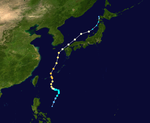1956 Pacific typhoon season
| 1956 Pacific typhoon season | |
|---|---|

Season summary map
|
|
| Seasonal boundaries | |
| First system formed | January 18, 1956 |
| Last system dissipated | January 1, 1957 |
| Strongest storm | |
| Name | Wanda |
| • Maximum winds | 325 km/h (200 mph) |
| • Lowest pressure | 910 hPa (mbar) |
| Seasonal statistics | |
| Total depressions | 39 |
| Total storms | 26 |
| Typhoons | 18 |
| Super typhoons | 5 |
| Total fatalities | >5,980 |
| Total damage | > $60.5 million (1956 USD) |
| Related articles | |
| Category 4 typhoon (SSHWS) | |
| Duration | March 21 – April 5 |
|---|---|
| Peak intensity | 215 km/h (130 mph) (1-min) 970 hPa (mbar) |
| Tropical storm (SSHWS) | |
| Duration | April 10 – April 15 |
|---|---|
| Peak intensity | 85 km/h (50 mph) (1-min) 1001 hPa (mbar) |
| Category 5 super typhoon (SSHWS) | |
| Duration | April 16 – April 25 |
|---|---|
| Peak intensity | 285 km/h (180 mph) (1-min) 935 hPa (mbar) |
| Tropical storm (SSHWS) | |
| Duration | June 16 – June 21 |
|---|---|
| Peak intensity | 85 km/h (50 mph) (1-min) 1000 hPa (mbar) |
| Category 1 typhoon (SSHWS) | |
| Duration | July 5 – July 9 |
|---|---|
| Peak intensity | 150 km/h (90 mph) (1-min) 982 hPa (mbar) |
| Category 5 super typhoon (SSHWS) | |
| Duration | July 25 – August 5 |
|---|---|
| Peak intensity | 295 km/h (185 mph) (1-min) 910 hPa (mbar) |
| Category 1 typhoon (SSHWS) | |
| Duration | August 2 – August 6 |
|---|---|
| Peak intensity | 130 km/h (80 mph) (1-min) 965 hPa (mbar) |
| Tropical storm (SSHWS) | |
| Duration | August 7 – August 10 |
|---|---|
| Peak intensity | 75 km/h (45 mph) (1-min) 998 hPa (mbar) |
| Category 3 typhoon (SSHWS) | |
| Duration | August 10 – August 19 |
|---|---|
| Peak intensity | 195 km/h (120 mph) (1-min) 960 hPa (mbar) |
The 1956 Pacific typhoon season has no official bounds; it ran year-round in 1956, but most tropical cyclones tend to form in the northwestern Pacific Ocean between June and December. These dates conventionally delimit the period of each year when most tropical cyclones form in the northwestern Pacific Ocean.
The scope of this article is limited to the Pacific Ocean, north of the equator and west of the international date line. Storms that form east of the date line and north of the equator are called hurricanes; see 1956 Pacific hurricane season. Tropical Storms formed in the entire west Pacific basin were assigned a name by the Fleet Weather Center on Guam.
A total of 39 tropical cyclones are made in the Western Pacific Basin. Of all the 39 tropical cyclones made, 23 of them reached tropical storm strength, 15 of them reached typhoon strength, and 3 of them reached the super typhoon strength. The rest of the storms, such as unnumbered and unnamed tropical depressions and storms, are only classified by the CMA while the JMA is sometimes rare before the 1960s - 1970s.
Typhoon Sarah formed at a low latitude on March 21 and took a generally northwest heading. On the 31st as it approached the Philippine islands, it slowed then reversed its direction dissipating on April 4.
Tropical Storm 02W formed on April 10. It hit Philippines as a tropical depression. It move westward hitting Vietnam dissipating on April 15.
On April 16, Thelma formed near the formation place of typhoon Sarah. Thelma struck the Philippine Islands on April 21 and passed close to Formosa on April 23 then struck Japan. The U.S. Navy Fleet Weather Central in Guam stopped following Thelma on April 25.
A tropical depression developed southwest of Guam on July 25. It moved north-northeastward, passing east of the Northern Marianas. On July 27, it intensified into a tropical storm and was designated Wanda. On the same day, the storm turned more westward, steered by the subtropical ridge to the north. Low wind shear and warm waters allowed Wanda to intensify steadily, developing into an intense typhoon while . On July 30, reconnaissance aircraft recorded a minimum pressure of 902 mbar (26.6 inHg), and the peak winds were estimated at 295 km/h (185 mph). After passing through the Miyako Islands, Wanda weakened slightly and traversed the East China Sea. On August 1, the typhoon made landfall in eastern China near Zhoushan, Zhejiang, producing a pressure of 923 mbar (27.3 inHg); this was the lowest pressure recorded in China from a tropical cyclone. Wanda slowly weakened while progressing through China, dissipating on August 5.
...
Wikipedia










